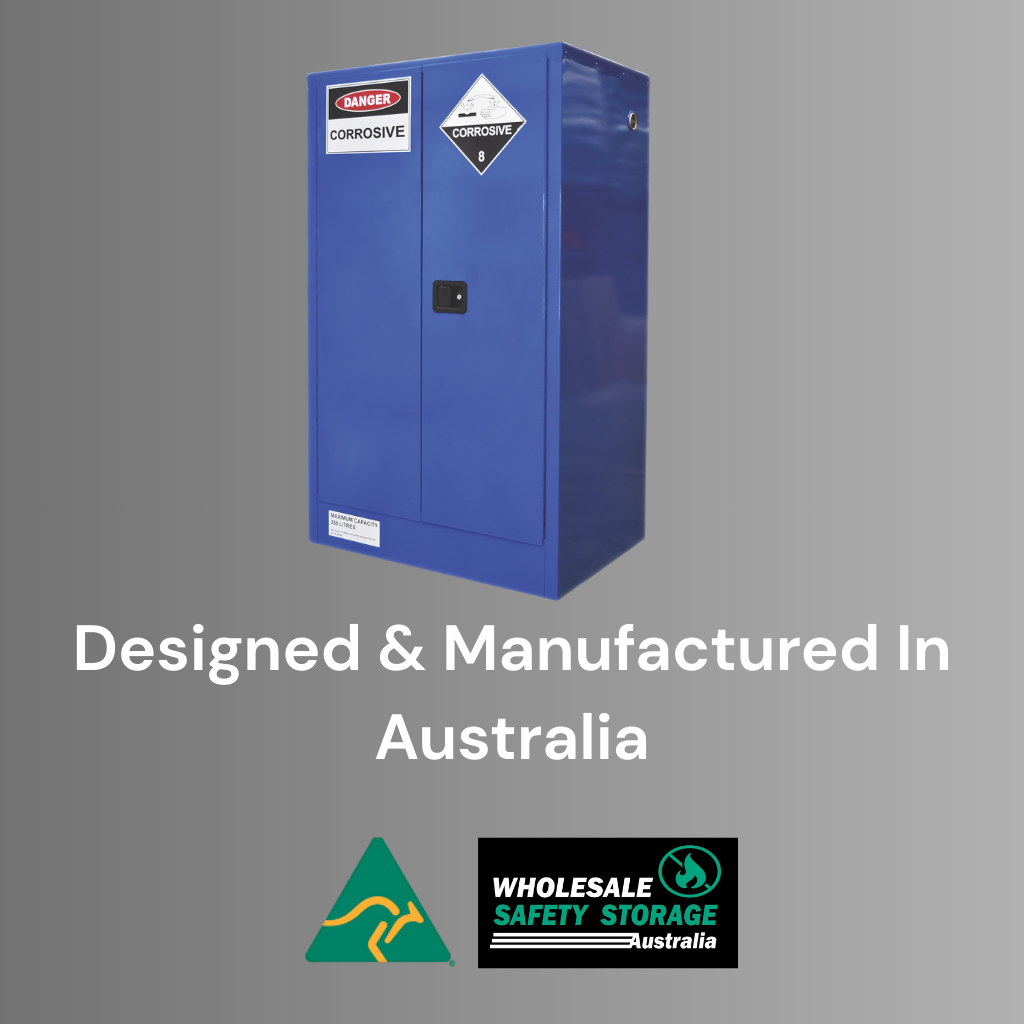AS 3780 Explained in Plain English: Storage & Handling of Corrosive Substances
A practical guide for site managers, HSE and procurement. What auditors look for, what AS 3780 means, and how to get audit-ready fast.
TL;DR
- AS 3780 is the Australian Standard for storing and handling corrosive (Class 8) substances.
- It covers cabinet design, chemical-resistant linings, self-closing doors, spill containment, ventilation, signage and segregation.
- Auditors, regulators and insurers benchmark your setup against AS 3780. Cabinets built to the Standard make inspections smoother.
- Choose AS 3780-compliant corrosive cabinets and follow segregation charts to reduce risk and stay compliant.
If your workplace stores acids, alkalis or other corrosive chemicals, you’ve probably heard of AS 3780. This article explains the Standard in everyday language so you can understand what auditors check, how to stay compliant, and how to keep your team safe.
What is AS 3780?
AS 3780 is the Australian Standard titled The storage and handling of corrosive substances. It applies to Class 8 (corrosive) liquids and solids under the ADG Code and sets minimum requirements for cabinet construction, spill containment (sumps), segregation of incompatibles, ventilation, signage and emergency measures.
Why AS 3780 matters
- Legal compliance: Reduces risk of improvement notices, fines or shutdowns.
- Insurance: Many insurers expect evidence your storage meets the relevant Australian Standards.
- Safety: Corrosives can burn skin/eyes, corrode metals and damage infrastructure if leaks occur.
- Audit-readiness: Compliant cabinets, clear segregation and documentation make inspections faster.
Key requirements (plain English)
- Approved corrosive cabinets: Use AS 3780-compliant indoor corrosive cabinets when quantities increase or where localised storage is needed near point-of-use.
- Double-walled steel with a thermal barrier (doors do not open inward).
- Self-closing, self-latching doors with multiple latching points.
- Liquid-tight spill sump under the floor to capture leaks (do not drill into the sump).
- Vent ports (typically with flash arrestors) available if a risk assessment calls for venting.
- Chemical-resistant internal finishes (e.g., thermoplastic coated shelves and base).
- Compliant warning signage and cabinet labelling.
- Spill containment & capacity: Ensure cabinet sumps are sized to contain credible leaks and that shelves/UDL ratings are not exceeded. Keep sumps clear (don’t use them for storage) and dispose of contaminated liquids appropriately.
- Segregation of incompatibles: Keep corrosives away from incompatible substances (e.g., oxidisers, flammables, toxics) and separate acids from bases. Use your site’s Dangerous Goods segregation charts and SDS guidance.
- Location & access: Place cabinets where they won’t obstruct exits or escape routes. Maintain clear access for emergency response, eye-wash and safety showers.
- Emergency infrastructure: Where corrosives are decanted/opened, provide eye-wash and safety shower within a short, unobstructed distance. Train staff in spill response and first aid.
- Operating procedures: Keep current SDS and a hazardous chemical register. Implement routine inspections (doors self-close, seals intact, sump empty, labels legible), and ensure PPE, spill kits and neutralising media are available.
Who needs to comply
Any facility storing or handling Class 8 corrosives (labs, manufacturing, water treatment, maintenance workshops, education) should align with AS 3780 and applicable WHS laws. If a product is both corrosive and flammable, apply AS 3780 and AS 1940 as relevant and segregate appropriately.
How WSSA helps
WSSA supplies Australian-made AS 3780-compliant corrosive cabinets (common sizes: 30 L, 60 L, 100–160 L, 250 L). Designs include double-wall construction with thermal barrier, self-closing doors, chemical-resistant shelves and bases, integrated sumps, vent ports and compliant signage. We can provide TDS, drawings and documentation for auditors and insurers.
- Browse the range: Indoor Corrosive Substances Cabinets
- Technical Data Sheets: WSSA Product TDS Library
- Segregation help: Dangerous Goods Segregation Charts
- Need advice? Speak with our team for layout and product selection support.
Quick FAQ
- Can I store acids and alkalis in the same cabinet?
- Best practice is to separate strong acids from strong bases. Use segregation charts and SDS guidance. If co-located, use clear physical separation and secondary containment that prevents mixing.
- Do I need to vent corrosive cabinets?
- Only where a risk assessment shows it’s required. If venting, use appropriate ducting/filters and preserve the cabinet’s fire/safety integrity. Never drill through the sump.
- What’s the most common audit fail?
- Non-closing doors, blocked sumps used as storage, mixed incompatibles, missing labels, and no nearby eye-wash/shower.
- What documentation should I keep?
- Current SDS, hazardous chemical register, cabinet TDS/spec sheets, inspection records, and training/spill response procedures.
Resources & next steps
- Download cabinet TDS documents and file them with your SDS for audits.
- Map incompatibles using our DG Segregation Charts.
- Book a quick call: WSSA storage & compliance support.
Disclaimer: This guide provides general information only. Each site remains responsible for its own risk assessment and compliance with the relevant Australian Standards and regulatory authorities.
